

Understanding dyslexia: 1.7.3 Differentiating dyslexia from other developmental conditions - OpenLearn - Open University - DSE212_1. Balanced Approach to Literacy Development in the Early Years. Reading, Vocabulary and Spelling. Crazy professor reading game. What can I do to support the dyslexic students in my primary class? Published in SPELD SA Newsletter, Autumn 2003 Students with dyslexia at this age may lose the motivation to try in response to repeated failure.
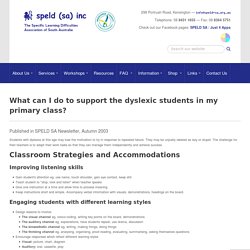
They may be unjustly labeled as lazy or stupid. The challenge for their teachers is to adapt their work tasks so that they can manage them independently and achieve success. Classroom Strategies and Accommodations Improving listening skills. Orton Gillingham Based Reading Intervention. Dear Parent, At Winsor Learning, nothing is more important to us than the continued progress your child makes while studying through distance learning.

Our hope for you and your family is that you are able to weather this storm as quickly and as painlessly as possible, but we know it’s not easy. Chromebook apps and extensions for learners with dyslexia. The THRASS Institute Events. 4 SPELLING. THRASS Colour Pics. THRASS SCOPE SEQUENCE 2018 VERSION. 4 SPELLING. TDFC UCLA 2018 – Barbara Wilson, M.Ed. – Foundation of Reading Acquisition and Dyslexia: Implications for Early Intervention. Phonemic Awareness and Dyslexia with Susan Barton. Open-Dyslexic Font. Dyslexia: An Ounce of Prevention... I recently read an article that suggested that children are not learning disabled until they attend school and fail to adequately learn to read and write.
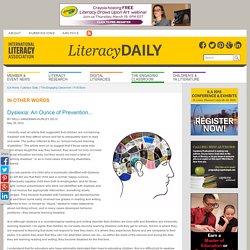
The author referred to this as “school-induced learning disabilities.” The article went on to suggest that if those same kids were simply taught the way they learned, they would not only not need special education services, but they would not need a label of “learning disabled,” or as in most cases of learning disabilities, dyslexia. Structural brain differences in kids with dyslexia - Reading. By Gordon Sherman, Ph.D.
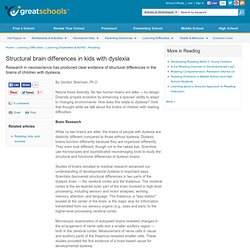
Nature loves diversity. No two human brains are alike — by design. So much more than words on a page. The More that you read, the more things you will know.
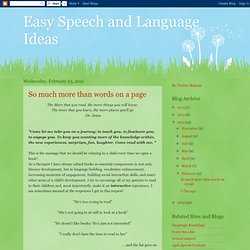
The more that you learn, the more places you'll go -Dr. Seuss "Come let me take you on a journey; to teach you, to fascinate you, to engage you. To keep you wanting more of the knowledge within, the new experiences, surprises, fun, laughter. What Parents Need to Know About Dyslexia (Reading Disability) — AAPOS. Sheryl M.
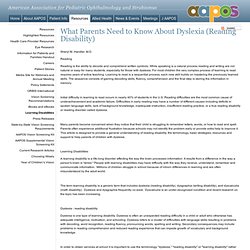
Handler, M.D. Yale Center For Dyslexia & Creativity. Dyslexia Test - 3 Things Everyone Should Know About Testing - Dyslexic Advantage. Reading Without Tears. Dyslexic Advantage. The International Dyslexia Association Promoting literacy throug. Why Copying from a Board is Ineffective for Dyslexics.
Saturday, May 9, 2015 Why Copying from a Board is Ineffective for Dyslexics Having to take notes by copying from a board or projection while a teacher is lecturing is challenging for any learner, because it requires students to multitask and constantly shift modes of learning.
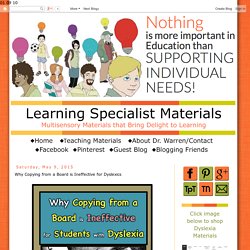
The process demands students to read, listen and write while making sense of the material. However, for students with dyslexia this teaching method can be disastrous. How Has Technology Impacted Note-taking? Before the rise of educational technology, students used to copy while the teacher wrote on the blackboard, however, with the use of devices such as the Smartboard and software like PowerPoint, the words just magically appear. Dyslexia Early Screening Test 25-April-2015-P-Cogan. 50 Interesting Facts About Dyslexia - Reading Horizons At-Home. The Literacy and Dyslexia-SpLD Professional Development Framework. Recognise_dyslexia.jpg 637×774 pixels. How to Help Kids Set People Straight About Dyslexia. Indications of Dyslexia- About Dyslexia- the British Dyslexia Association.
If a child has several of these indications, further investigation should be made.

The child may be dyslexic, or there may be other reasons. This is not a checklist. 1. Persisting factors. There are many persisting factors in dyslexia, which can appear from an early age. These include: Obvious 'good' and 'bad' days, for no apparent reason, Confusion between directional words, e.g. up/down, in/out, Difficulty with sequence, e.g. coloured bead sequence, later with days of the week or numbers, A family history of dyslexia/reading difficulties. 2.
Has persistent jumbled phrases, e.g. Literacy Lowdown- Feedback. Literacy Lowdown- Empowering Students on Their Journey as Readers. Literacy Lowdown- Word Study Activities. Maureen Hayes, PreK-6 Humanities Supervisor This Month's Focus: Meaningful Word Study Activities In my January/February Smore, I shared information for supporting word study and phonics development in your classroom.

20 Ways To Help Your Child Learn Their Sight Words. Welcome to my second blog in the series “Literacy in the Primary Classroom”.
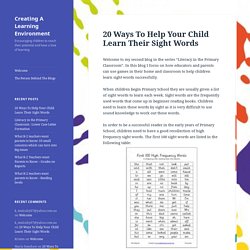
In this blog I focus on how educators and parents can use games in their home and classroom to help children learn sight words successfully. When children begin Primary School they are usually given a list of sight words to learn each week. Sight words are the frequently used words that come up in beginner reading books.
Children need to learn these words by sight as it is very difficult to use sound knowledge to work out these words. In order to be a successful reader in the early years of Primary School, children need to have a good recollection of high frequency sight words. Teachers use sight words in all literacy activities in the classroom. Below is a list of 20 sight word games that can be played at home and at school. Launching Young Readers. Seven Strategies to Teach Students Text Comprehension.
1. Monitoring comprehension Students who are good at monitoring their comprehension know when they understand what they read and when they do not. They have strategies to "fix" problems in their understanding as the problems arise. The Gift of Dyslexia, Revised and Expanded. Free online evaluation from Davis Dyslexia Association International. Dyslexia International. Dyslexia impacts the individual, society and the economy at large. Test for Dyslexia: 37 Common Symptoms. Teaching Strategies for Reading: Professional Development Resource.
Highlights SummerSummer is here! While most of your students will be on break from school for a few months, you can still engage their minds this summer. Try our summer reading suggestions, math and science worksheets, and cross-curricular resource packets to prepare kids for what the next school year will bring! June Calendar of Events June is full of events that you can incorporate into your standard curriculum. Our Educators' Calendar outlines activities for each event, including: Eric Carle's Birthday (June 25, 1929) and Paul Bunyan Day (June 28). Videos Interested in using different types of media in your classroom? Classroom Strategies. Teach the Seven Strategies of Highly Effective Readers. By: Elaine K. McEwan To improve students' reading comprehension, teachers should introduce the seven cognitive strategies of effective readers: activating, inferring, monitoring-clarifying, questioning, searching-selecting, summarizing, and visualizing-organizing.
This article includes definitions of the seven strategies and a lesson-plan template for teaching each one. To assume that one can simply have students memorize and routinely execute a set of strategies is to misconceive the nature of strategic processing or executive control. Such rote applications of these procedures represents, in essence, a true oxymoron-non-strategic strategic processing.— Alexander and Murphy (1998, p. 33) If the struggling readers in your content classroom routinely miss the point when "reading" content text, consider teaching them one or more of the seven cognitive strategies of highly effective readers. Instructional aids References. Improving Comprehension For Students With Dyslexia. What Is Dyslexia? As with other learning disabilities, dyslexia is a lifelong challenge that people are born with. This language processing disorder can hinder reading, writing, spelling and sometimes even speaking. Dyslexia is not a sign of poor intelligence or laziness.
It is also not the result of impaired vision. Children and adults with dyslexia simply have a neurological disorder that causes their brains to process and interpret information differently. Dyslexia occurs among people of all economic and ethnic backgrounds. ReadWriteThink. Lucid. What Is Dyslexia?
Strategies for Teaching Reading Comprehension. Comprehension of Fiction video by The Jerry L. Johns Literacy Clinic at Northern Illinois University Upon completion of this section, you will: Understand the components of reading comprehension Receive ideas for making the text personally relevant Learn how to teach active engagement with the text Obtain extension activities for all learning styles. Teaching Special Needs Children : Teaching Students With Dyslexia. FAT City: Reading and Decoding. Teaching Students with Dyslexia and Dysgraphia: Lessons from Teaching and Science. Helping dyslexic children within the classroom.